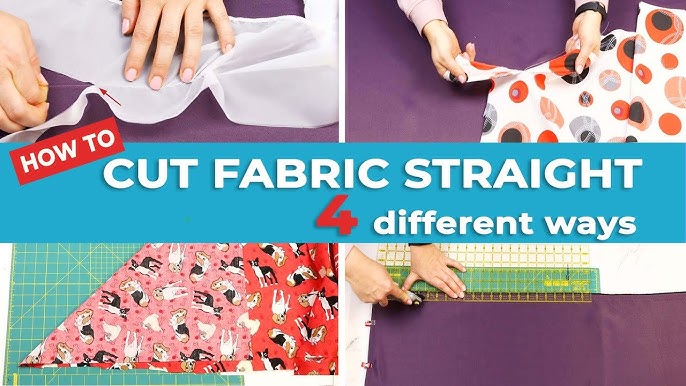Advice On How To Cut Different Fabrics

You have your pattern. You have your gorgeous fabric and you want to get on with sewing it. I understand that you want to end your cutting as soon as possible. Yet there is more to cutting than using scissors to cut the fabric. If you intend to take your sewing seriously, that is.
Poor cutting will result in a messy garment. It is guaranteed. Acquire some fundamental knowledge of cutting and you are good to go. Accurate and precise cutting is essential for a professionally finished garment.
Trying to cut plain fabric
It’s easy to get confused by this cloth because both sides look nearly identical. You’ll need to use chalk to make markings on the front of the fabric before you can cut it. The side that lacks any visible weave lines can be used as the front.
How to cut leather or leather-like fabric
Using a rotary cutter and mat to cut leather or synthetic leather will save you a lot of time and aggravation. This in no way precludes the usage of scissors. However, a rotary cutter provides the cleanest cut.
If you’re using a pattern, imitation leather is not a good place to pin it. It’s best to use pattern weights instead of pins because holes in the fabric look terrible. The pattern can be clipped to the edges with paper clips or binder clips.
Fabric with a printed design; instructions for cutting
In my opinion, one of the best parts of making your own clothes is matching prints along the seams. This sort of thing is unusual in retail clothing. Envision a printed pencil skirt with mismatched prints down the back. That will be very jarring to the eye.
Cut across the lengthwise grain if you’re working with striped, plaid, or otherwise printed fabric. If you’d rather, you can just read the print. Fabric pattern components should be cut from a single layer of cloth. The next step is to find another object with a similar design and place it next to the first.
Advice on cutting striped fabric
While cutting stripes, it’s crucial to remember to give each side the same number. If not, it risks seeming uneven. The middle should be positioned between or on the stripes at the front and back.
Choosing to cut the fabric in longitudinal stripes will give the wearer the appearance of being slimmer, and this direction should also be considered while cutting sleeves.
Striped fabric can be intriguing if cut on the diagonal and sewn back together. New designs are made by creatively piecing together strips of striped fabric.
Cloth with a design or pattern
Getting matching prints on opposite sides of printed garments can be tricky, especially when working with a limited amount of fabric. If precise pattern matching is essential, it is necessary to purchase extra cloth.
Tips for cutting chiffon and other slippery fabrics
Trimming slippery textiles requires you to maneuver through a complex and often frustrating area. Tissue paper or other thin paper can be used as a safety layer while cutting these textiles. Cut with scissors that have a blade with serrations.
The cloth can be made heavier by lightly wetting it with a spray bottle. Yet the cutting board needs to be handled with care. It would be foolish to risk damaging a hardwood table like mine.
You can forego the step of cutting out your pattern pieces before sewing if you’re working with an impossibly large piece of cloth. Yes, this is a rumor, but you have to take the shortcuts you can. The fabric should be marked with the pattern. Do some different types of seams. Use appropriate seam allowances when cutting it out after stitching.
Techniques for cutting delicate fabrics
Fabrics that are soft and pliable like tissue paper can be cut with the help of a thin paper or tissue paper that is kept nearby.
Directional patterns
When working with printed textiles, it’s crucial to pay attention to the prints’ orientation before you begin cutting. You definitely don’t want the pattern to end up on your sewed clothing backward. Before beginning to cut, make sure that all of the pattern pieces are facing the same way.
When working with a fabric that has a directional design, it’s important to ensure that all of your pattern pieces are cut facing in the same direction. In order to get the desired print on the fabric, it must be held in one direction.
It’s possible that there’s a certain section of the clothing where you’d like a certain print to appear. This is to also be taken into consideration while buying the fabric and placing patterns
If you want your prints to line up perfectly along the seams, you’ll need extra fabric than the design calls for. This is because when we cut one side of the pattern, you will need to look throughout the rest of the fabric for a matching part with the same print. Look for a print with a seam allowance that matches along the seam as well.
Don’t throw away the already cut-out piece from the corresponding printed piece. Make a cutting guide and marks around it. Invisible zippers along the a seam material for hoodies makes it impossible to tell that the cloth panel is actually made of two different parts.
Napped fabrics or pile fabrics
Fabrics with a pile, such as a velour, plush, or imitation fur, should be combed down and cut in one continuous direction.
You should also be aware of whether or not the material you have in your possession has a nap. This is a major factor that must be taken into account because it affects the overall aesthetic of the garment.
Cutting fabric with an improper nap can have disastrous results, as the cloth’s actual hue may appear different from what was intended. Think of how one of your sleeves looks in comparison to the other. Fabric pieces cut with varying naps might look radically different and unusual in different lighting, which may not be noticeable at a first glance or a casual glance.
You may see by running your hand over it that the nap has to be flattened out.




